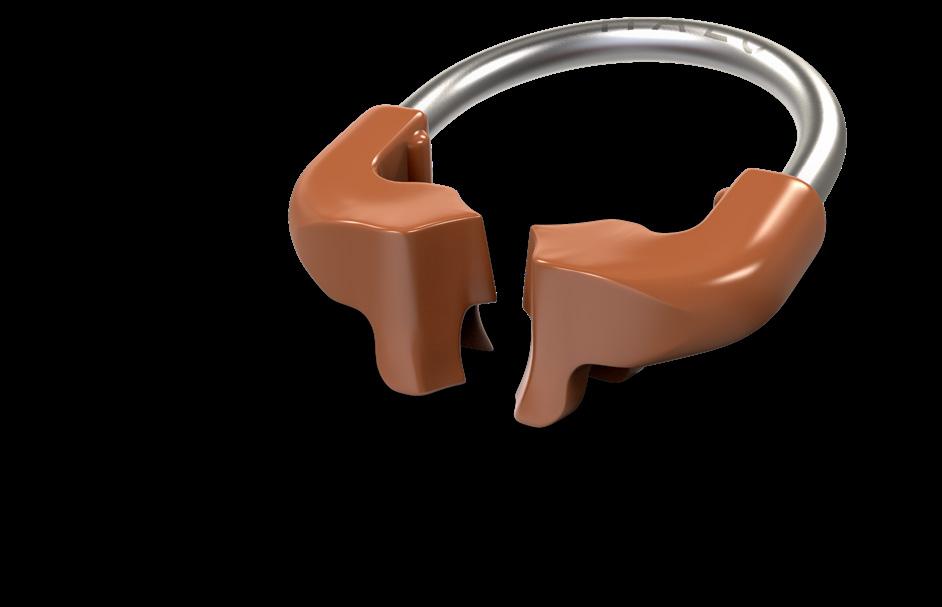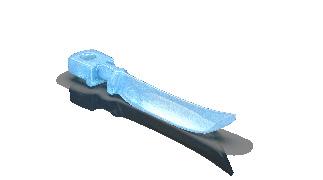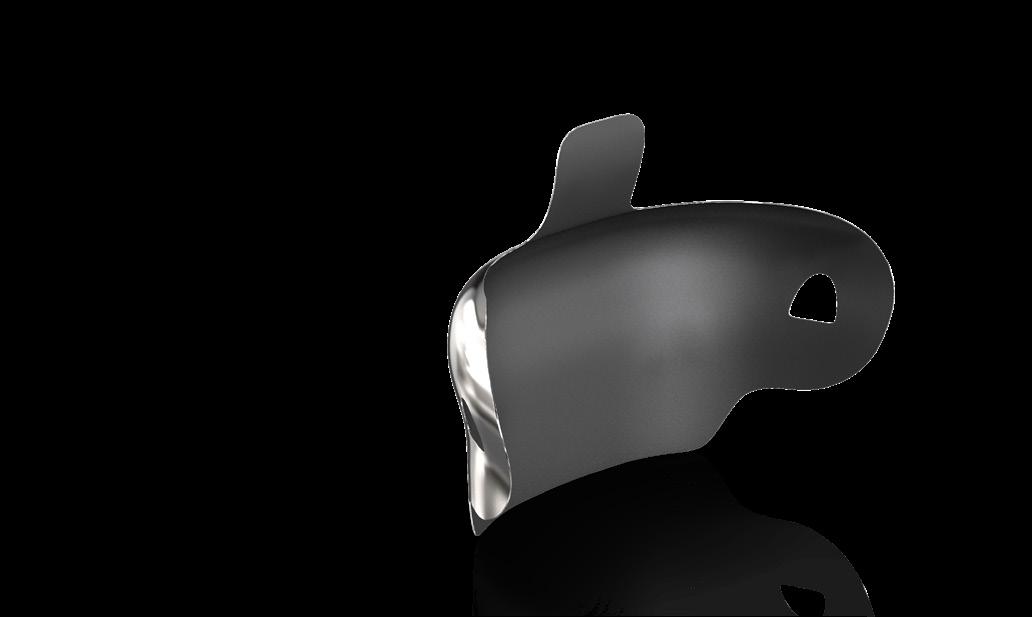Halo™ Sectional Matrix System White Paper

INTRODUCTION
The restoration of the proximal surface of Class II cavities has always been an important objective for the dental practitioner. There are several reasons why the reestablishment of optimum form and function is important: support, alignment, and stabilization of the dentition are the fundamental ones. Also, the protection and preservation of both tooth and interdental gingival papilla, and consequently, the rest of the periodontal complex. A good contact between teeth helps to prevent food impaction and deter the formation of proximal carious lesions.
Several features like the correct interproximal form or contour (embrasure shape), optimum proximal contact surfaces, consistent marginal ridge elevations, and central groove continuity within a dental arch are paramount. Absent or open contacts and/or proximal contact surfaces may give room to poorly aligned dentition, which in turn may cause food impaction, halitosis, caries formation, and periodontal disease—just some of the reasons why the knowledge of accurate tooth anatomy is essential for a functional dental rehabilitation.
With the requirement of so many anatomic details, the optimum form and function associated
Dr. Rafael Beolchi
with the proximal surface tooth anatomy has included numerous obstacles over the years, especially after the improvement of esthetic materials to be used in the posterior region. If by one side the development of new toothlike composite resins and bonding technique allowed for conservation of tooth structure, by the other it brought new challenges and problems.
Tight, well-contoured proximal contact areas in the posterior region were more easily achieved with dental amalgam, especially due to its mechanical properties and handling characteristics. Today, composite resin has replaced the metallic direct material as the posterior restorative material of choice, with reports of it being used in at least 58% of posterior restorations according to some studies. The way in which posterior composite restorations are now placed went through a rapid change in the last few years, greatly because of the change and improvements in composites’ composition and formulas, and the new materials and technologies available. Nevertheless, persistent challenges are still encountered by the practitioner, and new improvements in this field will be discussed further ahead.
MATRIX SYSTEMS
In order to facilitate the reconstruction of proximal contact surfaces, several different matrix systems have been proposed. The re-creation of proximal anatomy is based on three pillars: the matrix or band, the wedges (generally made of wood or plastic), and the device responsible for holding the matrix in place (the matrix retainer). It is important to note that a rapid separation is also desired, which is usually accomplished by the wedge, the ring (in systems where it is available as the matrix retainer), or both. In the last decades, all three: matrices, wedges, and ring (matrix retainers) went through rapid changes and development.
Historically, the Tofflemire system is probably the most popular matrix system. When used with amalgam, it produced good and predictable anatomy and contact points. Today, it is still employed for insertion of composite resin, being widely used around the world. However, more developed matrix systems have been introduced, bearing great characteristics more suitable for the demands posed by composites. One of the main reasons is because of the peculiarities of the contact point that is obtained with the use of the Tofflemire matrix systems—usually too close to the occlusal surface. It is common that after even the initial occlusal adjustments, the contact point is lost due to this proximity. Another common mishap is when there is a fracture of this anatomical portion of the restoration.
Ring matrix systems that include a separation ring, sectional matrices, and custom-fitted plastic wedges have become popular, with one of the first matrix systems being introduced in the 1990s. It was the first generation to utilize this concept exclusively as the restoration of posterior teeth using composite resin increased.
MECHANICAL SEPARATORS
Tooth displacement is achieved with a maximum interdental separation of about 0.55 kg/mm, and it is important to compensate for the thickness of the matrix when this one is removed. According to Owens et al. (2016), “The practice of flossing has traditionally been the method for the evaluation of proximal contact achievement, with designations of tight, weak, or open.” Even though it is an empirical form of classification, the distinctive “click” felt when the dental floss goes through the proximal restored area is usually a good sign, and something that many dentists seek, as it usually implies a good contact point.
It is good to remember that in the days of the dental amalgam, both the expansion suffered by the material and the packing required by the insertion technique greatly helped the dentist to achieve a good contact point/surface between the posterior teeth. With the passivity of insertion when using composite materials, the pressure delivered by the separation ring (or spring clamp) systems and the wedges became responsible for the separation force. This combination (ring and wedges) should guarantee the movement of the tooth and compression of the periodontal ligament space, allowing for an improved separation.
The idea behind rings (or clamps) is to provide the separation necessary to achieve proper interproximal anatomy. From the myriad of designs available, some do not adapt well to the interproximal-occlusal anatomy, failing to provide a good contact between matrix and tooth. This in turn results in flash on the margins of the restoration that must be dealt with in the finishing step. Others allow for a tighter contact,
2 Halo™ Sectional Matrix System White Paper
but sometimes they misshape the matrix band, collapsing it in cases where a wider Class II cavity is present or a cusp is missing. There is also the problem of some rings being too bulky to be used in challenging areas, such as what happens to the second upper molar region.
A novel concept on this field, the Halo™ Sectional Matrix System Ring proposes a solution with a unique beak design with built-in anatomical contours that mimic the natural anatomy and helps to decrease the finishing time. (Figure 1)


The Ni-Ti metallic ring is fabricated with glassfilled nylon tines that are strong and rigid, which presents a 3D anatomy. This unique design provides a better separation, and at the same time, adapts the sectional matrix more tightly around the tooth without collapsing it on the margins where wider Class II restorations are present. (Figure 2)
As for the other component responsible for separation, the wedges, these can be fabricated in many materials. The most popular design is still the wooden wedges. Available in many sizes they are a popular material, but can be harmful for the gingival papilla. On one side they provide a good separation force, on the other this happens with the expense of compressing, sometimes harming, this portion of the periodontal apparatus.
Another fundamental role of the interdental wedge is to help adapt the matrix band, providing a good contour and a perfect fit to the tooth structure. Since the interproximal region is blocked from direct view after the completion of the restoration, this is important to avoid any hidden overhangs, and the subsequent risk of recurrent decay due to bacterial colonization.
For this purpose, a new shape has been proposed in the last decade which is gentler to the soft

tissues. It has a V-shape, and it helps to achieve a better adaptation to the interproximal region. The problem is that some of the wedges may be too soft, therefore helping to adapt the matrix to the tooth, but failing to provide a good separation.
Figure 2
design but are also firm (Figure 3). This new material provides an active wedging for enhanced separation, but makes the wedge gentle to the gingival papilla and easy to place. It also allows the wedges to be stacked when multiple wedges are needed, providing a perfect adaptation between the matrix band and the tooth, making sure no overhangs will be present on the final restoration.
MATRICES
One of the main purposes of the matrix (band) is to contain the restorative material so it can be shaped into the proper lost proximal anatomy. Matrices can be either circumferential or sectional. They are the fundamental part for achieving the proper anatomy of the tooth, as it is the type of matrix system and not the composite resin material that is primarily responsible for the tooth anatomy.
Halo™ Sectional Matrix System White Paper
Figure 3
Figure 1
That is exactly one of the main problems of the Tofflemire-type matrices when used with composites: it delivers an anatomy too parallel or too trapezoidal in relation to the tooth. As mentioned above, the contact point obtained is too close to the occlusal surface, and with occlusal adjustments, it might be removed. In addition to the lack of a well-contoured profile from occlusal to cervical, they are likely to create problems for the gingival papilla region in terms of food impaction. Also situations like these are more prone to fracture over time because of the masticatory loading.
A class of matrices worth mentioning is the automatrices, sometimes used because of their ease of placement. However, these matrices usually present the same anatomical setbacks similar to those of the circumferential, discussed above.
Novel designs in matrix shapes and thickness (together with new rings and wedges) allowed for a better and predictable anatomy, both in occlusal and proximal, the so-called sectional matrices.
One of the reasons why the sectional matrix provides an improved interproximal anatomy with proper marginal adaptation is because such systems can be customized according to the variety of the shapes and surfaces of the proximal surfaces of different teeth. However, it is necessary that a ring (and/or the wedge) acts as a displacement force, otherwise, there’s always the risk of getting a suboptimal contact surface contour. In case of excessive separation force, the matrix might get wrinkled.
There are two types of curvatures in the metallic bands for the Halo Sectional Matrix System: one is the “wrap-around” curvature, going from lingual to buccal, and the other curvature goes from gingival to occlusal (Figure 3). The buccal-lingual
curvature is unique to each size of band and it is not incrementally sized, giving the right anatomy for the right tooth. When used with its uniquely designed ring, the matrix is adapted rather than “smashed” against the tooth. In that way, it is possible to achieve both a good separation and the proper anatomy at the same time.

The Halo band’s curvature also has a natural anatomical shape based on measurements from actual teeth, and the curve at the marginal ridge creates ideal occlusal embrasure, reducing finishing time and occlusal adjustments. (Figure 4)
There are no doubts that composite resins have achieved prominence as a posterior Class II restorative material. Improvements in both mechanical and optical properties led to greater survival rates, sometimes similar to those typically and historically found with amalgam restorations.
Still, difficulties persist regarding the insertion of these materials. Poor anatomy with open and/or deficitary proximal contacts may cause food impaction, a well-known factor for the recurrence of secondary caries as well as a potential cause for periodontal problems.
As stated by Owens et al. (2016), “An ideally reconstructed proximal surface, taking into consideration both anatomical and occlusal factors, aids in the prevention of food impaction and subsequent periodontal disease. The stimulation of oral tissues and/or stabilization of the dentition within an arch and the opposing occlusion are achieved through correctly applied principles of current, evidence-based methodologies.”
Halo™ Sectional Matrix System White Paper
Figure 4
CONCLUSION
One of the primary challenges for dentists when restoring posterior teeth using composite resin is the establishment of anatomically correct proximal contacts.
It is well-known that sectional matrices and separation rings for insertion of Class II composite resin restorations resulted in stronger contact surfaces compared to the utilization of traditional circumferential (Tofflemire) bands and wood wedges. The usage of the latter in conjunction with current materials (such as composite resin) may lead to clinical failure and decreased longevity of these restorations.
A properly contoured proximal region with a sealed interface (no overhangs or porosities) and an anatomically correct occlusal and ridge anatomy is what should be achieved in every posterior Class II restoration.
As new matrix systems appeared, what was considered a very difficult task began to become more predictable—that is, achieving a properly contoured Class II restoration with composite materials.

Today, a new matrix system has moved further ahead, refining the anatomy provided by the matrix, the adaptability of the ring, and the separation force of the wedges. The innovations brought by the Halo Sectional Matrix System allow clinicians to achieve a more precise proximal contact surface with anatomically correct contours faster and more easily, a fundamental step for optimum form and function of the dentition as well as for stimulation and protection of the periodontal complex.
REFERENCE
Owens BM, Phebus JG. An evidence-based review of dental matrix systems. Gen Dent. 2016 SepOct;64(5):64-70. PMID: 27599285.
Dr. Rafael Beolchi graduated from the University of São Paulo, Brazil in 2000. He has maintained a private practice since 2001, working mainly in esthetic dentistry and oral rehabilitation. In 2009, he received a master’s degree in Biomaterials. He lectures around the world, mainly on the advanced handling of dental materials with an easy step-by-step approach. He now lives in Portugal where he is pursuing his second master’s degree.

5 Halo™ Sectional Matrix System White Paper
©2022 Ultradent Products, Inc. All rights reserved. 012022 800.552.5512 | ULTRADENT.COM
DR. RAFAEL BEOLCHI







